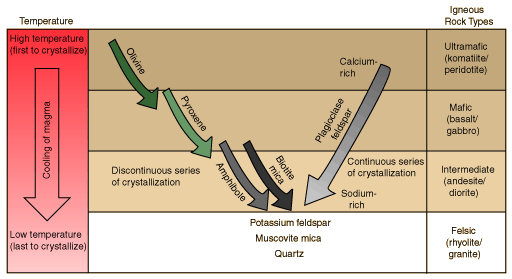Rocks and Minerals B/C
-
-Groundhog-
- Member

- Posts: 26
- Joined: April 17th, 2016, 4:22 pm
- Division: B
- State: WA
- Has thanked: 0
- Been thanked: 0
Re: Rocks and Minerals B/C
I'm having trouble with identification (no surprise). How do you get really good at that? What do you practice with?
- Magikarpmaster629
- Exalted Member

- Posts: 578
- Joined: October 7th, 2014, 3:03 pm
- Division: Grad
- State: MA
- Has thanked: 0
- Been thanked: 1 time
Re: Rocks and Minerals B/C
Flashcards. Use multiple images of the same mineral/rock so you see the variability. Making your binder also helps. And if you can afford it, the R&M kit from Ward's Science https://www.wardsci.com/store/catalog/p ... 470223-058 will help you for competition since they usually have real specimens.-Groundhog- wrote:I'm having trouble with identification (no surprise). How do you get really good at that? What do you practice with?
On an unrelated note, I have trouble differentiating diatomite and chalk. Anyone have advice?
-
-Groundhog-
- Member

- Posts: 26
- Joined: April 17th, 2016, 4:22 pm
- Division: B
- State: WA
- Has thanked: 0
- Been thanked: 0
-
DoReMiFossil
- Member

- Posts: 7
- Joined: January 24th, 2016, 9:39 am
- Division: C
- State: MA
- Has thanked: 0
- Been thanked: 0
Re: Rocks and Minerals B/C
It's December and I haven't really studied yet oops, so this may be a dumb question. Are we expected to be able to definitively ID things based on picture alone or will there be cases where we'll need other identifying info in order to accurately ID?
- azuritemalachite
- Exalted Member

- Posts: 129
- Joined: October 9th, 2014, 5:57 pm
- Division: C
- Has thanked: 0
- Been thanked: 1 time
Re: Rocks and Minerals B/C
Usually, there's a specimen or a picture which you ID and then there will be questions about that certain specimen (like composition, common name, etc.), but nothing else except maybe a magnet. I'm not sure if ES will provide streak plates since it's not on the rules.DoReMiFossil wrote:It's December and I haven't really studied yet oops, so this may be a dumb question. Are we expected to be able to definitively ID things based on picture alone or will there be cases where we'll need other identifying info in order to accurately ID?
To ID you can just use flashcards(like Karp has said)/a Quizlet (the games help with speed) and there are certain characteristics that each mineral/rock will have.For example, galena is a dense, silver metallic mineral that has a cubic system (therefore it is boxy) and is NOT magnetic, so by using that information, you can match up minerals and rule out other ones. The mineral/rock boxes are useful, but they will often have very obvious specimens (good for starting off with), so you definitely want to look into more trickier specimens later.Magikarpmaster629 wrote:Flashcards. Use multiple images of the same mineral/rock so you see the variability. Making your binder also helps. And if you can afford it, the R&M kit from Ward's Science https://www.wardsci.com/store/catalog/p ... 470223-058 will help you for competition since they usually have real specimens.-Groundhog- wrote:I'm having trouble with identification (no surprise). How do you get really good at that? What do you practice with?
On an unrelated note, I have trouble differentiating diatomite and chalk. Anyone have advice?
Chalk is softer and powder-like whereas diatomite is grainier and less dense. Both are pretty flaky though.
This is a pretty good method; my binder is similar to this.Clematis wrote:No problem! I have one page per mineral/rock with all the information that the rule sheet suggests with composition, streak, etc. and then in the front and back of the binder I have notes for additional stuff such as Bowman's Reaction Series. Each individual section is marked off by dividers for easier navigation.Llamastwaimzjf wrote:Thanks. In what format did you write your binder of notes?
Quartz is in the silica group; the list has quartz as its own subgroup since we're expected to ID a lot of varieties. The crystal form is basically just the normal clear kind.RE02 wrote:I have a question for the quartz section. For the classification, is it "quartz" or "silica group"?
Also, when it tells us to get info on "crystal", what mineral is that, as the name is kind of vague?
mindat.org or min.det usually have a lot on minerals.animechicadee wrote:Does anyone know any good sites that tell you the properties of garnet and mica? I can't seem to find one and I need one quick, I've got an invitational in 9 days!


Re: Rocks and Minerals B/C
Is grade of metamorphism only for metamorphic rocks? Because I cant find anything for igneous or sedimentary.
Also, what is Bowen's Reaction Series, and is it different for every rock?
Also, what is Bowen's Reaction Series, and is it different for every rock?
- Magikarpmaster629
- Exalted Member

- Posts: 578
- Joined: October 7th, 2014, 3:03 pm
- Division: Grad
- State: MA
- Has thanked: 0
- Been thanked: 1 time
Re: Rocks and Minerals B/C
Yep, since only metamorphic rocks have metamorphosed, there is only a grade of metamorphism for metamorphic rocks. However, metamorphic rocks do have parent rocks (e.g. slate's parent rock is shale, a sedimentary rock) which I guess you could think of as a 0th grade metamorphism; a rock that, once metamorphosed into another rock, is metamorphic.RE02 wrote:Is grade of metamorphism only for metamorphic rocks? Because I cant find anything for igneous or sedimentary.
Bowen's Reaction Series is for igneous rocks- it's basically the order in which different minerals crystalise as magma rises. As the magma rises, it cools from very high temperatures; minerals with higher melting points will crystalise first and those with lower melting points crystalise last. Here's a typical chart:RE02 wrote:Also, what is Bowen's Reaction Series, and is it different for every rock?

- Entomology
- Member

- Posts: 118
- Joined: September 17th, 2015, 1:56 pm
- Division: C
- State: CA
- Has thanked: 0
- Been thanked: 1 time
Re: Rocks and Minerals B/C
So let me get this straight, Agate/Onyx are varieties of Chalcedony, which is a variety of quartz. In addition, this means the varieties of Agate/Onyx (Ex. Banded Agate) are theoretically varieties of chalcedony. Why are Agate/Onyx varieties of chalcedony and not all the other quartzs as well? All the quartzes share chemical formula, crystal system, hardness, etc so why is Agate/Onyx specifically a variety of chalcedony only?
CCA '20 Captain
Herpetology, Fossils, Boomilever, Mousetrap Vehicle
Herpetology, Fossils, Boomilever, Mousetrap Vehicle
- Unome
- Moderator

- Posts: 4323
- Joined: January 26th, 2014, 12:48 pm
- Division: Grad
- State: GA
- Has thanked: 229 times
- Been thanked: 82 times
Re: Rocks and Minerals B/C
Not entirely sure, but if I remember correctly, chalcedony is defined as quartz without a visible crystal structure, so maybe because agate & onyx have no visible crystal structure, while other quartzes do?Entomology wrote:So let me get this straight, Agate/Onyx are varieties of Chalcedony, which is a variety of quartz. In addition, this means the varieties of Agate/Onyx (Ex. Banded Agate) are theoretically varieties of chalcedony. Why are Agate/Onyx varieties of chalcedony and not all the other quartzs as well? All the quartzes share chemical formula, crystal system, hardness, etc so why is Agate/Onyx specifically a variety of chalcedony only?
Re: Rocks and Minerals B/C
I can't find info on garnet schist and mica schist as separate rocks; everywhere I look has them as one rock, but the list has them as two separate ones. Does anyone have a website or resource I could use? (:
Who is online
Users browsing this forum: No registered users and 1 guest

